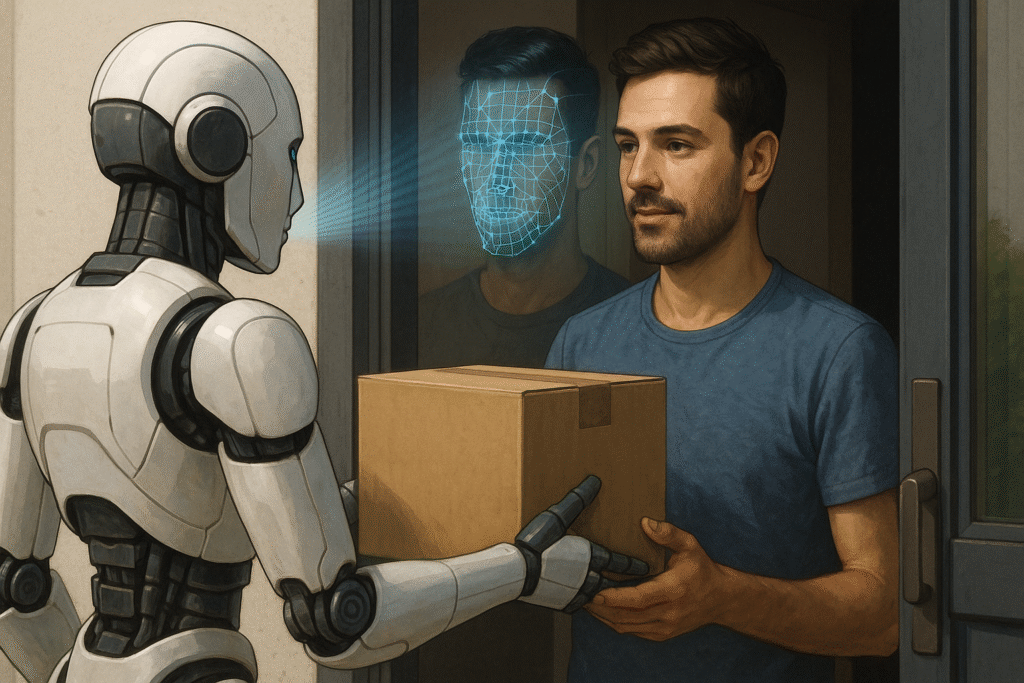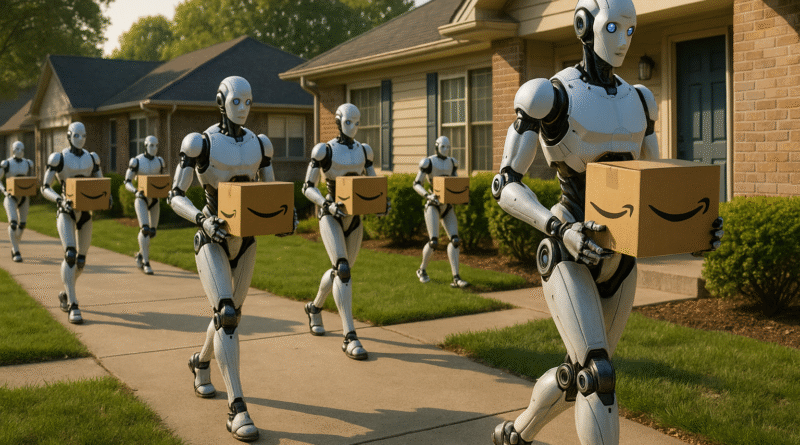Amazon’s Bold Move: Humanoid Robots Set to Transform Last-Mile Delivery
Amazon Humanoid Robots Introduction
Imagine ordering a package online and instead of a delivery driver showing up at your door, it’s a humanoid robot, walking, balancing, and carrying your package with surprising grace (and maybe even offering a friendly robotic wave).
Sound like a Black Mirror episode?
Well, it might soon be your Amazon Prime reality.
In 2025, Amazon is officially testing Amazon humanoid robots to assist with warehouse workflows and last-mile deliveries. These aren’t just glorified vending machines on wheels, we’re talking bipedal robots that resemble human movement, powered by cutting-edge AI and designed to navigate real-world environments.
So, what does this mean for delivery workers, consumers, and the future of logistics? Let’s unpack this (pun very much intended).
Why This Is a Big Deal
For years, Amazon has invested in automation, from Kiva warehouse bots to Scout sidewalk delivery units. But Amazon humanoid robots represent a huge leap. Why?
Because they:
- Can operate in human-designed environments (stairs, curbs, uneven ground)
- Require less infrastructure change compared to wheels or drones
- Can mimic human dexterity for carrying, stacking, even knocking on doors
And with labor shortages, rising shipping demands, and increasing consumer expectations for faster, more efficient deliveries, Amazon sees Amazon humanoid robots as a potential key to scaling logistics without scaling costs.
Meet Digit: Amazon’s Humanoid Robot Partner
Amazon’s humanoid delivery pilot reportedly centers around Digit, a bipedal robot developed by Agility Robotics.
Digit’s key features:
- Walks upright on two legs
- Carries up to 35 pounds
- Navigates stairs and tight spaces
- Uses computer vision to avoid obstacles
- Designed to be safe around humans (non-threatening form factor)
Digit isn’t a new player, it’s been tested in industrial settings since 2020. But Amazon’s pilot could mark its first major real-world deployment in consumer logistics.
What Amazon Humanoid Robots Bring to Delivery
1. Last-Mile Flexibility
Final delivery points (your porch, apartment hallway, office lobby) are chaotic, inconsistent, and tough for wheeled robots or drones.
Humanoids can:
- Climb stairs
- Navigate crowds
- Open doors
- Drop off packages where humans do, not just curbside
2. Human-Compatible Workflows
Warehouses, delivery routes, and urban environments are built for human dimensions, doorways, elevator buttons, shelves.
Instead of redesigning the world for robots, humanoids are being designed to adapt to our world.
3. Workforce Augmentation, Not Replacement
Amazon positions robots like Digit as collaborators, not replacements. They’ll do repetitive, injury-prone tasks while human workers focus on supervision, exception handling, and customer service.
That said… we’ll get to the labor debate in a minute.
Challenges and Limitations
Let’s be real: Amazon humanoid robots aren’t perfect. They’re still in early stages, and several obstacles remain.
Battery Life
Most bipedal robots only last 1–2 hours of continuous operation before needing a recharge.
Speed & Efficiency
They walk slower than humans and are not as efficient as traditional vans or bike couriers over long distances.
Weather & Terrain
Rain, snow, gravel, and ice? Still a challenge for bipedal machines to handle reliably.
Public Perception
Robots walking the streets can trigger discomfort, confusion, or even vandalism. (We’ve seen delivery bots kicked, blocked, or drawn on.)
Security
How do we ensure packages aren’t stolen from robots? Or that the robot itself doesn’t get hijacked?
How This Fits Into Amazon’s Bigger Automation Strategy
Amazon has been doubling down on automation for over a decade. Here’s how humanoid delivery fits into the bigger picture:
| Automation Tier | Tool/Technology | Role in Logistics |
| Fulfillment Centers | Kiva robots, robotic arms | Sorting, lifting, stacking |
| Delivery Station | Autonomous sorting bots | Package routing and load balancing |
| Middle-Mile Transport | Self-driving trucks (Zoox) | Autonomous shipping between hubs |
| Last-Mile Delivery | Scout, Drones, Digit | Getting the package from hub to doorstep |
Humanoid robots like Digit could be the missing link in the last mile, arguably the most expensive and logistically complex step in the chain.
Will This Replace Human Delivery Jobs?
That’s the million-dollar (or billion-dollar) question.
Amazon is careful to say that robots augment, not replace, workers. But history shows that automation often leads to job displacement, especially in repetitive, low-skill sectors.
Key considerations:
- Some delivery roles may evolve into robot monitors, maintenance techs, or logistics coordinators
- Other roles may be phased out over time, especially in high-density urban routes
- In rural or unpredictable areas, human judgment will likely remain essential for now
Bottom line: Robots are likely to change the job, not eliminate it overnight.
Consumer Experience: What It Might Look Like

You place an order. A few hours later:
- A robot is loaded into an autonomous van.
- It hops out at your building.
- Walks to your unit door.
- Confirms your name using facial or voice recognition.
- Delivers the package.
- Sends a photo confirmation.
- Walks back and reboards the van.
Cool? Creepy? Convenient?
Probably a mix of all three, at least at first.
Ethical & Privacy Questions
AI-powered humanoid delivery raises questions:
- Will robots record surroundings (cameras/mics)?
- What data is stored from each delivery?
- Can a robot make ethical decisions in public spaces?
- Who’s liable if a robot trips, falls, or injures someone?
These issues must be addressed before robots become a sidewalk staple.
FAQ
Q1: Are these robots autonomous or remote-controlled?
A1: They’re mostly autonomous, but can be monitored or overridden by human operators in case of issues.
Q2: When will I see one on my doorstep?
A2: Still in pilot phase. You might see them in limited test cities before widespread rollout (likely post-2026).
Q3: Are other companies testing humanoid delivery robots?
A3: Yes, startups like Figure AI, Apptronik, and Tesla are all developing humanoid platforms with potential for delivery and logistics roles.
Final Thoughts
The sight of a humanoid robot dropping off your next package might seem futuristic, but it’s already being tested. Amazon’s pilot program is a glimpse into a world where machines don’t just think, they walk, deliver, and maybe smile, too (digitally, of course).
Whether this becomes the new normal or just a stepping stone in logistics evolution, one thing is clear:
AI isn’t just managing warehouses anymore, it’s knocking at your door.
Want to stay ahead of the AI curve? Keep following aihunterguides.com, where we track emerging tech, challenge the hype, and decode the future, one algorithm at a time.
